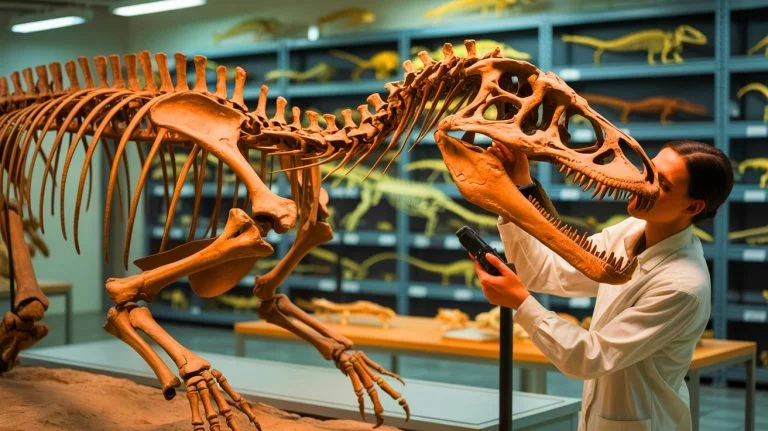| IN A NUTSHELL |
|
In the heart of Germany’s Jurassic past, a remarkable discovery has been made in the dusty reserves of a museum. A nearly forgotten skeleton, unearthed almost fifty years ago, has revealed a new species of marine reptile. This plesiosaur, with its unusually long neck, has been identified as Plesionectes longicollum. Its rediscovery is reshaping our understanding of early plesiosaur evolution. The specimen had been languishing unstudied in the Staatliches Museum für Naturkunde in Stuttgart. Now, thanks to modern analytical tools, it is providing insights into the diverse adaptations of marine life in the Jurassic era.
A Chance Discovery in Holzmaden’s Reserves
The fossil-rich site of Holzmaden, nestled in the Posidonia Shale formation, has long been a treasure trove of exceptionally preserved marine skeletons. In 1978, paleontologists uncovered a complete specimen there, which was subsequently transferred to the Staatliches Museum für Naturkunde in Stuttgart. Despite its remarkable condition, the fossil was never fully analyzed. It was cataloged under reference SMNS 51945 and presumed to be a variant of already known species, before being forgotten in the museum’s reserves.
Recently, researchers Sven Sachs and Daniel Madzia revisited these bones using modern comparative analysis tools. Their study, published in the journal PeerJ, revealed a unique combination of anatomical features never before seen in a Jurassic plesiosaur. One of the standout aspects of this discovery is the preservation of fossilized soft tissues, a rarity for specimens from this era. This detail has elevated the paleontological significance of the fossil, highlighting its value and prompting a reevaluation of its classification.
Plesionectes Longicollum: An Anatomical Marvel
Measuring approximately 10.5 feet in length, with its neck alone spanning 4 feet, Plesionectes longicollum boasts a slender build and an unprecedented vertebral series. The creature had at least 43 cervical vertebrae, setting a record among plesiosaurs of its time, as noted in the researchers’ phylogenetic analysis. The V-shaped arrangement of neurocentral sutures and the low height of the neural spines also indicate distinctive traits, rarely observed in combination.
Though its skull was badly damaged, scientists managed to identify key features, including a notably developed posterior bony outgrowth. The study also uncovered a unique structure in the skeletal girdles and limbs, suggesting an original locomotor specialization in this individual, which was still immature at its time of death. The skeleton, despite its youth, presents a stable combination of characteristics that justify the establishment of a new genus and species. According to Phys.org, this discovery pushes the origin of certain evolutionary traits further back than previously assumed.
Insights Into Jurassic Marine Crises
Plesionectes longicollum lived during the Early Toarcian period, about 183 million years ago. This era was marked by extreme climate events, including a rapid increase in atmospheric CO₂, ocean warming, and a significant reduction in dissolved oxygen in the seabed. This scenario, known as the Toarcian Anoxic Event, led to widespread marine extinction.
The presence of this species in the early deposits of the Posidonia Shale suggests that some marine reptiles managed to adapt to these harsh conditions. According to the study, Plesionectes longicollum is currently the oldest plesiosaur identified in this region, predating the five other known species from Holzmaden. It provides further evidence of certain lineages’ resilience to major environmental stresses. By enhancing the taxonomic diversity of this troubled period, the fossil demonstrates that the evolution of marine ecosystems does not follow a linear trajectory. The subsurface archives still hold traces of unexpected life forms, waiting to be uncovered by patient paleontologists.
The Role of Museums in Scientific Discovery
This rediscovery underscores the critical role museums play in scientific research. Often, significant finds are not made in the field but in the collections already housed within museum walls. These institutions serve as custodians of historical treasures, where reevaluations can yield groundbreaking insights. The Plesionectes longicollum is a testament to this, emerging from obscurity to challenge and expand our understanding of marine life evolution.
As tools and technologies advance, the potential for further discoveries in museum collections grows. Every specimen has a story to tell, and sometimes the most profound narratives come from those hidden in plain sight. What other secrets might be awaiting discovery within the vaults of our museums?
Did you like it? 4.4/5 (20)







This is mind-blowing! Imagine stumbling upon such a discovery in a dusty old museum. 😮
Are there any living species with a neck similar to Plesionectes longicollum?
It’s fascinating how much history is just sitting in museum collections waiting to be uncovered.
I’m curious about the neck length. How did it affect the creature’s movement and feeding habits?
Love to see more about how they used modern tools to analyze the fossil. Science is amazing!
Is there any chance that more fossils of this species could be found at Holzmaden?